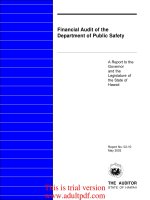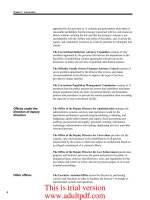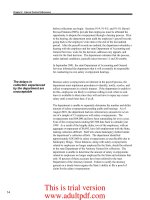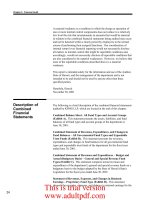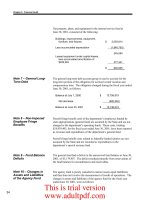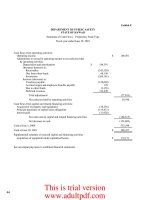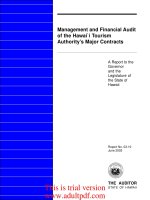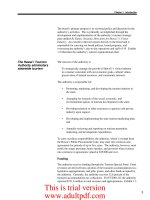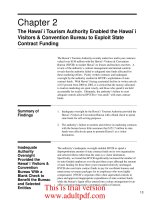Financial Audit of the Hawaii Public Employees Health Fund A Report to the Governor and the Legislature of the State of Hawaii_part2 doc
Bạn đang xem bản rút gọn của tài liệu. Xem và tải ngay bản đầy đủ của tài liệu tại đây (148.1 KB, 11 trang )
4
Chapter 1: Introduction
1. To assess the adequacy, effectiveness, and efficiency of the systems
and procedures for the financial accounting, internal control, and
financial reporting of the Health Fund; to recommend improvements
to such systems, procedures, and reports; and to report on the
financial statements of the Health Fund.
2. To ascertain whether expenditures and other disbursements have been
made and all revenues and other receipts have been collected and
accounted for in accordance with federal and state laws, rules and
regulations, and policies and procedures.
3. To make recommendations as appropriate.
The Auditor’s contract with Deloitte & Touche LLP requires an audit of
the financial records and transactions and a review of the related systems
of accounting and internal controls of the Health Fund for the fiscal year
July 1, 1997 to June 30, 1998. Included in the scope of work were all
fund types and account groups except for the general fixed assets account
group. The contract also provides for review of the Health Fund’s
transactions, systems, and procedures for compliance with applicable
laws and regulations.
To the extent possible, we examined the existing accounting, reporting
and internal control structure. We identified deficiencies and weaknesses
in the internal control structure and made recommendations for
improvement.
The independent auditors’ report on the combined financial statements
presented in Chapter 3 is that of Deloitte & Touche LLP. The work was
conducted from July 1998 through December 1998 in accordance with
generally accepted government auditing standards.
Objectives of the
Audit
Scope and
Methodology
This is trial version
www.adultpdf.com
5
Chapter 2: Internal Control Deficiencies Exist
Chapter 2
Internal Control Deficiencies Exist
Internal controls are steps implemented by management to ensure that
objectives are met and resources are safeguarded. This chapter presents
our findings and recommendations on the financial accounting and
internal control practices and procedures of the Hawaii Public Employees
Health Fund (Health Fund).
We found management to be ineffective in administering the Hawaii
Public Employees Health Fund. The serious deficiencies in the financial
reporting of the Health Fund’s fiscal operations led the certified public
accounting firm of Deloitte & Touche LLP to express an opinion that the
Health Fund’s fiscal 1998 financial statements are not presented fairly in
accordance with generally accepted accounting principles. In addition,
management’s lack of adequate controls to verify certain financial
information and monitor the contracts with the insurance carriers resulted
in weak accountability of interest income, reserves, and executed
agreements. Also, the Health Fund’s operating relationship with the
executive and legislative branches of the State needs to be improved in
order to fulfill its statutory requirements.
1. Financial statements are not being prepared in accordance with state
law and generally accepted accounting principles. The board of
trustees are required to maintain accurate records and accounts of all
financial transactions of the Health Fund in accordance with
Sections 87-29(2) and (3), Hawaii Revised Statutes (HRS). The
Health Fund is following the accounting principles established for
governmental-type activities whereas it should be following the
accounting principles established for business-type activities. Not
following the appropriate accounting principles results in an
inaccurate reporting of the Health Fund’s assets, liabilities, revenues,
and expenses. Approximately $294 million of revenues and $203
million of expenses were not reported by the Health Fund.
2. A lack of clarity between the Health Fund and its insurance carriers
as to the definition and measurement of rate stabilization reserves has
resulted in substantial excess reserves. State law allows the insurance
carriers to hold reserves in order to stabilize health benefits plan
premium rates. Any amount in excess of such rate stabilization
reserves is required to be returned to the State and counties. Because
the definition and measurement of reserves lacks clarity, the Health
Fund has allowed the insurance carriers to hold substantial reserves in
excess of the amount required to stabilize future premium rates. In
Summary of
Findings
This is trial version
www.adultpdf.com
6
Chapter 2: Internal Control Deficiencies Exist
addition, an insurance carrier that benefited from holding reserves
was required to pay only the Health Fund’s 5 percent interest on these
reserves. The rate was negotiated by the board of trustees for the
benefit of the Health Fund members. However, the low negotiated
rate and substantial excess reserves resulted in the State and counties
not having access to millions of dollars that belonged to them.
3. The interest income earned on the reserves held by the insurance
carriers is not being monitored. With one exception, the Health Fund
has no agreements with the insurance carriers that specify the interest
rates to be used or any reporting requirements. Accordingly, the
Health Fund is unable to determine whether the insurance carriers are
reporting the proper amounts of interest.
4. The agreements with the insurance carriers to provide health care
benefits that were in effect during the 1998 fiscal year have not been
signed (with the exception of the carrier providing life insurance
benefits and one carrier providing dental benefits). Without signed
agreements, the Health Fund may face difficulties in trying to enforce
certain provisions of the agreements.
5. The Health Fund has not been able to implement a long-term care
insurance benefit plan, as required by law, nor has it been able to
return excess premiums to employees because it has not obtained
approval from the executive and legislative branches of the State to do
so. Funding requests to implement a long-term care plan have been
denied. Legislative bills that would authorize cash refunds of excess
premiums to employees have failed to pass. Accordingly, the Health
Fund has not been able to carry out two of its mandated functions.
The Hawaii Public Employees Health Fund (Health Fund) is controlled by
a nine-member board of trustees (Board) which administers and carries
out the purpose of this fund. The Board has appointed an administrator
and staff to fulfill its requirements and state laws.
The Board and the administrator are tasked with managing the Health
Fund; however, they are ineffective in meeting statutory financial
reporting standards, defining and controlling rate stabilization reserves,
monitoring and executing insurance carrier agreements, and implementing
a statutorily required long-term care insurance benefit plan. Heavy
reliance on consultants may contribute to the difficulties of meeting these
requirements.
Management’s
Ineffective
Administration of
the Health Fund
Results in Serious
Problems
This is trial version
www.adultpdf.com
7
Chapter 2: Internal Control Deficiencies Exist
Sections 87-29(2) and (3), HRS, require the Board of the Health Fund to
maintain suitable and adequate records for the fund’s operations and
accurate records and accounts for all financial transactions. However, the
fund’s accounting records are so deficient that these statutory
requirements are being violated.
In addition, the fund’s financial statements should follow standards that
make them accurate, consistent, and readable by many users. The Health
Fund prepares annual financial reports that are read by state and county
employers, active and retired employees and their beneficiaries, insurance
carriers, and legislative bodies. Therefore, its reports should be prepared
accurately and in accordance with proper accounting standards. This was
not done.
The Health Fund’s failure to follow the proper accounting and financial
reporting standards was serious enough to warrant an adverse opinion
from the certified public accounting (CPA) firm of Deloitte & Touche
LLP on the Health Fund’s June 30, 1998 financial statements. An
adverse opinion, the worst possible opinion that is issued by CPA firms,
concludes that the financial statements are not presented fairly in
accordance with generally accepted accounting principles. Only in
extreme and rare cases is an adverse opinion given, which magnifies the
Health Fund’s reporting deficiencies. Failure to comply with the proper
accounting and reporting standards violates Sections 87-29(2) and (3),
HRS, and places the State at risk when trying to determine the true
financial condition of and cost to operate the Health Fund.
The Governmental Accounting Standards Board of the Financial
Accounting Foundation (GASB) issues accounting and financial reporting
standards for governmental entities. The GASB has issued standards
specifically for agencies called public entity risk pools. A public entity
risk pool is defined as a cooperative group of governmental entities
joining together to finance a risk, such as employee health care. The
Health Fund meets this definition and, accordingly, is considered to be a
public entity risk pool.
Governmental entities use different fund types to account for their
governmental-type and business-type activities. The GASB requires all
public entity risk pools to account for their activities in a business-type
fund, called an enterprise fund. However, instead of business-type funds,
the Health Fund incorrectly uses the governmental-type general,
expendable trust, and agency funds. This means that the public does not
get an accurate picture of the Health Fund’s financial activities. Because
the Health Fund is using the wrong accounting principles, it is
inaccurately reporting financial transactions that impact its assets,
liabilities, revenues and expenses. For example, under accounting
standards applicable to enterprise funds, the Health Fund should be
reporting the premiums collected from the State, counties and employees
Financial reporting
violates state law and
fails to comply with
accounting standards
This is trial version
www.adultpdf.com
8
Chapter 2: Internal Control Deficiencies Exist
as revenues, and its payments to the insurance carriers as expenses. Had
the Health Fund followed the proper accounting standards, it would have
recorded revenues of approximately $294 million and expenses of
approximately $203 million for the year ended June 30, 1998. Failure to
record these revenues and expenses results in a significant reporting
weakness that is misleading to all users.
In addition, generally accepted accounting principles require that the
underwriting gains and interest income, which are held by insurance
carriers and used to offset future underwriting losses during the contract
period, not be recorded as assets until the expiration of the contract
period. The Health Fund incorrectly recorded $17.4 million in
underwriting gains, as well as $2.1 million of related interest income, as
assets as of June 30, 1998.
The measurement focus and basis of accounting are substantially different
for business-type (e.g., an enterprise fund) and governmental-type funds.
For example, the measurement focus of a business-type fund is on the
flow of economic resources (“Is the fund better or worse off economically
as a result of this transaction?”); whereas the measurement focus of a
governmental-type fund is on the flow of current financial resources (“Are
there greater or fewer resources that can be spent in the future as a result
of this transaction?”) In addition, the basis of accounting of a business-
type fund utilizes a full accrual basis, whereas a governmental-type fund
uses a modified accrual basis. The full accrual basis records revenue
when earned; the modified accrual basis records revenue when measurable
and available for use.
We believe that the Health Fund’s failure to follow proper accounting and
financial reporting standards is caused in part by the Board’s and the
administrator’s lack of direction and training of accounting staff in
current, relevant accounting standards. The GASB standard for public
entity risk pools was issued almost ten years ago, in November 1989, and
became effective for fiscal periods beginning after June 1993. However,
the Health Fund’s current accounting and financial reporting policies have
not changed substantially since the mid-1980s; therefore, it has been
deficient in complying with state law and accounting standards for almost
six years.
We recommend that management comply with state law and account for
and report the Health Fund’s financial activities as required by generally
accepted accounting principles. In addition, management should ensure
that the accounting staff improve their knowledge of generally accepted
accounting principles applicable to the Health Fund.
Recommendation
This is trial version
www.adultpdf.com
9
Chapter 2: Internal Control Deficiencies Exist
Act 276, Session Laws of Hawaii (SLH) 1997, amended Section 87-3,
HRS, to allow the Health Fund to use rate credits or reimbursements from
insurance carriers to stabilize health benefit plan premium rates. Any
amount in excess of such rate stabilization reserves is required to be
returned to the State and counties.
We found that there is confusion among the Health Fund’s management
and the insurance carriers regarding the definition and measurement of the
rate stabilization reserves; as a result, insurance carriers retain millions of
dollars of excess reserves that rightfully belong to the State, counties, and
employees.
Act 276 did not include a definition of what constitutes a rate stabilization
reserve, and the Health Fund does not have a document defining such a
reserve. Also, the Health Fund’s contracts with the insurance carriers
vary in how reserves are defined and handled. We found that only the
contracts for the medical plans with Hawaii Medical Service Association
(HMSA) identify a dollar amount for reserves. For active employees, the
reserves were $7,460,494 for FY1997-98 and $10,367,771 for
FY1998-99. For retired employees, the reserves for FY1997-98 and
FY1998-99 are $8,458,520.
None of the other insurance contracts specify an amount for rate
stabilization reserves. This inconsistency and lack of definition for rate
stabilization reserves allowed HMSA to retain reserves for its benefit.
For example, the Health Fund’s agreement with HMSA provides for 5
percent interest earnings on the reserves held by HMSA to be credited to
the Health Fund. However, during the period of HMSA’s contract,
indexes for equity investments (stocks)—such as the Standard and Poor’s
(S&P) 500—reported an average return on investments of over 28.2
percent per year from 1996 - 1998. This index is used in the investment
industry to measure the average return on an investment in 500 selected
companies in the nation and is a good measure or standard of what an
investor could expect to receive in a given time period. This index is 23.2
percent higher than what HMSA is crediting to the Health Fund.
If HMSA invested the State’s rate stabilization reserves in the S&P 500
companies, it could have earned approximately $19 million in one year
($81 million in reserves multiplied by 23.2 percent), which would have
benefited only HMSA and not the Health Fund. Clearly, the rate of 5
percent negotiated by the Board is extremely low and raises questions as
to the Board’s effectiveness in establishing rates in the best interest of the
Health Fund.
Furthermore, the unclear definition of a rate stabilization reserve allowed
the insurance carriers to keep underwriting gains as rate stabilization
reserves. Underwriting gains are those that result from an insurance
carrier collecting more premiums than it pays out in claims and expenses.
Management’s failure
to define reserves and
establish adequate
interest rate earnings in
insurance carrier
agreements could prove
costly to the State
This is trial version
www.adultpdf.com
10
Chapter 2: Internal Control Deficiencies Exist
Underwriting losses occur when claims and expenses exceed the amount
of premiums collected. Most of the Health Fund’s contracts with
insurance carriers allow an underwriting loss during a contract period
(usually two or three years) to be offset against an underwriting gain from
another year, as well as against the rate stabilization reserve plus accrued
interest. At the end of the contract period, all net underwriting gains,
stabilization reserves, and accrued interest remaining must be returned to
the Health Fund. Any net underwriting loss is absorbed by the insurance
carriers.
Although insurance carriers are contractually required to return all net
underwriting gains, stabilization reserves, and accrued interest at the end
of a contract period, the Health Fund has allowed the insurance carriers to
retain such funds. In addition, in 1996, the Health Fund further violated
this statutory requirement by transferring $38 million of its investment
funds to the insurance carriers. We were informed that these transfers
were made to enable the fund to earn a higher rate of return. By the end
of FY1997-98, the deposits with insurance carriers had grown to
approximately $86 million. Of this amount, approximately $81 million
was held by HMSA under its medical and prescription drug plans. The
next largest amount was approximately $3 million held by Hawaii Dental
Service under its dental plans.
Act 141, SLH 1998, sought to remedy this situation by requiring excess
reserves to be returned to the State and counties effective July 1, 1998.
Management requested each insurance carrier to determine the amount of
excess reserves being held, and a total of $43.4 million was identified by
the insurance carriers. While this amount is substantial, a previously
agreed-upon determination of a rate stabilization reserve by the Health
Fund’s management and the insurance carriers may have resulted in a
higher amount. It could also be argued that the one-year growth in
reserves of approximately $18 million in FY1997-98 should be considered
excess reserves and also returned to the Health Fund.
Management contracted with a national actuarial and employee benefits
consulting company to assist the Health Fund in establishing operating
requirements and contracting with the insurance carriers. Even with
assistance from the consultant, management failed to define a rate
stabilization reserve, enforce a contract provision requiring the insurance
carriers to return excess reserves, or negotiate an adequate interest rate on
reserves. These deficiencies caused the State and counties the loss of the
use of millions of dollars. The magnitude of the reserves kept by HMSA
and the extremely low rate of interest negotiated by management raises
serious concerns about management’s prudent oversight of the fund’s
resources.
This is trial version
www.adultpdf.com
11
Chapter 2: Internal Control Deficiencies Exist
We recommend that management clarify the definition of a rate
stabilization reserve, enforce the provisions of the contracts with the
insurance carriers which require the return of excess reserves to the State,
and negotiate adequate interest rate earnings on reserves to the Health
Fund.
The Health Fund’s contracts with insurance carriers stipulate that the
carriers must pay interest on the funds they hold. However, because
management does not request supporting documents verifying interest
earnings and other financial information from certain carriers, the Health
Fund is not able to monitor the amount of interest income that is being
earned and reported by the carriers. The annual interest earned amounts
to millions of dollars, since the Health Fund allowed the insurance carriers
to hold $86 million of the fund’s reserves at June 30, 1998. The lack of
control procedures to verify interest earnings raises serious concerns over
management’s accountability for all revenues, not just interest earnings.
Accountability for all revenues is essential to protecting the Health Fund’s
assets.
Except for the medical contracts with HMSA, contracts with the
insurance carriers lack a specification of the rates used to accrue interest
on the amount of funds held. Since no minimum interest rate is stated in
most contracts, insurance carriers may not be maximizing their efforts to
attain a reasonable rate of return. If such is the case, the Health Fund has
no recourse against the insurance carriers.
In addition, the Health Fund has not required insurance carriers to report
interest earnings on reserves held or to verify them with investment
statements. While most of the carriers provide the Health Fund with
monthly reports of amounts they hold, only a few of the carriers report the
interest earnings on these amounts. To determine the amount of interest
earned, the Health Fund relies on annual confirmation letters sent by the
Health Fund’s independent auditors to the insurance carriers.
The carriers reported a total of $2.5 million of interest income for
FY1997-98. If this is accurate, then 2.9 percent is the approximate
interest earnings rate on the over $86 million held by the insurance
carriers. Because of a lack of oversight and contract management, the
Health Fund is unable to determine whether this amount is the actual
amount that should have been reported, or whether the rate of return is
reasonable.
Recommendation
Controls over the
monitoring of interest
income are weak
This is trial version
www.adultpdf.com
12
Chapter 2: Internal Control Deficiencies Exist
We recommend that during the next contract renewal period, management
negotiate the minimum interest rates to be earned by the insurance
carriers. In addition, the Health Fund should require the carriers to
provide a quarterly report on the interest earned and the reserve amounts
held. The Health Fund could then determine the accuracy of interest
earnings reported by insurance carriers.
Section 87-22, HRS, allows the Board to contract for certain health
benefit plans. The Health Fund has contracts with various insurance
carriers to provide health care and life insurance benefits. Exhibit 2.1
lists the Health Fund’s signed and unsigned insurance carrier contracts.
Recommendation
Management is
operating with
unsigned insurance
carrier contracts
Exhibit 2.1
Listing of Signed and Unsigned Insurance Carrier Contracts, June 30, 1998
Contract:
Insurance Carrier and Plan Signed or Unsigned
1. Hawaii Medical Service Association: Medical – Active employees Unsigned
2. Hawaii Medical Service Association: Medical – Retired employees Unsigned
3. Kaiser: Medical and Drug – Active and retired employees Unsigned
4. Kapiolani Health Hawaii: Medical – Active and retired employees Unsigned
5. Hawaii Medical Service Association: Prescription Drug – Active employees Unsigned
6. Hawaii Medical Service Association: Prescription Drug – Retired employees Unsigned
7. Vision Service Plan: Vision Care – Active employees Unsigned
8. Vision Service Plan: Vision Care – Retired employees Unsigned
9. Hawaii Dental Service: Adult Dental Care – Active employees Unsigned
10. Hawaii Dental Service: Adult Dental Care – Retired employees Unsigned
11. Hawaii Dental Service: Children’s Dental Care –
Dependents of active and retired employees Unsigned
12. DentiCare: Adult and Children’s Dental Care –
Active and retired employees and their dependents Signed
13. Grand Pacific Life Insurance Company: Life insurance –
Active and retired employees Signed
This is trial version
www.adultpdf.com
13
Chapter 2: Internal Control Deficiencies Exist
All of the contracts identified in Exhibit 2.1 should be effective from
July 1, 1996 through June 30, 1999. However, as of June 30, 1998, with
the exception of Grand Pacific Life Insurance Company and DentiCare,
none of the contracts were properly executed by the Health Fund.
According to the Health Fund, its deputy attorney general did not approve
signing the contracts. Nevertheless, the deputy attorney general declined
to provide us with a written confirmation that the contracts were valid and
enforceable.
Since management is required to protect the interest of the fund and
members served, its failure to properly execute the contracts not only
means the enforcement of contract provisions is unlikely but also that both
the Health Fund and the State are at risk if contractual disagreements
arise.
Among the more sensitive contract provisions are those relating to
premium amounts, retention percentages for administrative expenses,
measurement of reserves for claims incurred but not reported, terms of
measurement of gains and losses, application of surplus funds, and
contract extension periods. Disagreements about any of these provisions
could seriously jeopardize the operations of the Health Fund and could
result in additional costs being incurred.
We recommend that management ensure that contracts with insurance
carriers are timely and properly executed.
Because the Health Fund was created by state law and is administratively
attached to the Department of Budget and Finance, many of its major
undertakings require approval beyond that of its Board (i.e., at the
executive or legislative branch level). We found that management’s
inability to obtain such approvals hampers carrying out two of its major
functions.
Act 334, SLH 1989, authorized the Health Fund to implement and
administer a long-term care insurance benefit plan for the State and
county employee-beneficiaries and their dependents. However, such a
plan is still non-existent.
Long-term care is what people who can no longer care for themselves
require. Such people need help performing many activities of daily living
Recommendation
Failure to Meet
Statutory
Requirements Has
Negatively
Impacted
Members’ Benefits
A long-term care
insurance benefit plan
has not been
implemented
This is trial version
www.adultpdf.com
14
Chapter 2: Internal Control Deficiencies Exist
including eating, bathing, and dressing. Long-term care can be given in a
wide range of settings, from private homes to residential nursing facilities.
Long-term care insurance can be a viable means of meeting the often high
cost of long-term care because Medicare generally covers very few of
these expenses and Medicaid is available only after a patient’s personal
resources have been exhausted.
In 1991, the Health Fund contracted with a consultant to report on the
issues and provide recommendations related to establishing a long-term
care insurance plan. However, eight years after the study, management
has not been able to obtain approval to adopt such a plan or to follow up
on the study. Management submitted budget requests for the 1991-93,
1993-95, and 1995-97 biennium periods, but these funding requests were
denied.
We understand that a long-term care plan can be established with only
employee contributions. Third-party administrators could assess fees to
the plan out of interest earnings from employee contributions; therefore,
initial state appropriations may not be needed to implement a plan.
Although the Legislature approved the expenditure of $150,000 of Health
Fund moneys for an actuarial study on long-term care, during the 1998
legislative session it denied the Health Fund’s request to expend $103,000
for the implementation of a long-term care insurance plan. Management
believes that the legislatively approved study benefits all state residents,
not only Health Fund beneficiaries. Accordingly, management does not
believe that this is a proper expenditure of its funds and has sought the
advice of the Departments of Budget and Finance and the Attorney
General. As a result, implementation of a long-term care plan will be
further delayed.
The Health Fund is required by Act 276, SLH 1997, to return excess
reserves that were paid by the State and the counties. Act 141, SLH
1997, defines the amount to be returned effective as of July 1, 1998.
However, the disposition of the excess reserves paid by employees and
retirees (approximately $13 million as of June 30, 1998) is unclear.
Act 276, SLH 1997, indicates that any excess reserves derived from
employee contributions may be used to improve the health benefit plans or
to reduce the employees’ monthly contributions to a health plan, as in a
premium holiday. The act does not specifically address whether or not
providing cash refunds to the employees is allowable.
Management does not believe that providing premium holidays to
employees is the fairest way to dispose of the excess reserves. This is
Millions of dollars in
excess reserves have
not been returned to
members
This is trial version
www.adultpdf.com
